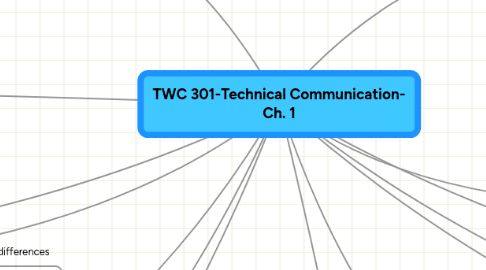
1. (HTW) Clairty (pg. 68)
1.1. Essential to effective Communication with readers
2. Activities of Technical and Professional Communication
2.1. Planning
2.2. Researching
2.3. Organizing
2.4. Drafting
2.5. Designing
2.6. Integrating Visuals
2.7. Revising
2.8. Rewriting
2.9. Editing
2.10. Testing
3. Chapter 2: Rhetoric and Technical Communication
3.1. workplace Problems :plan
3.1.1. New node
3.2. Rhetorical Problems
3.3. Audiences
3.4. workplace writers
3.5. Draft
3.6. Review
3.7. Contexts and Constraints
3.8. Documents
3.8.1. Distribute
4. Chapter 3: Technical Communication and Electronic Technologies
4.1. Impact of Technology
4.2. Keeping up with Progress
4.3. CREATING DOCUMENTS
4.4. Word Processors
4.5. Presentation Software
4.6. Graphics and Imaging Software
4.7. Web authorizing Software
4.8. Desktop Publishing Software
4.9. Help and E-Learning Toos
4.10. Single-Sourcing Programs
4.11. COMMUNICATING AND COLLABORATING
4.12. The Internet
4.13. WWW
4.14. E-Mail
4.15. Ethics and Electronic Communication
4.16. E-Messaging
4.17. Video Confrencing
4.18. Groupware
4.19. THE FUTURE OF WORKPLACE WRITING AND COMPUTER TECH
5. Chapter 4: Ethics and the Workplace Writer
5.1. What is ethics?
5.2. Ethics and the workplace Writer
5.3. Ethical guidelines for WW's
5.4. Ethics in context
5.5. Situation Perspective
5.6. codes of ethics
5.7. Ethics and Technology
5.8. Websites
5.9. Visuals
5.10. Environment
5.11. Avioding Unethical writing
6. Chapter 5: technical communication in a Transnational World
6.1. Learning about differences
6.1.1. Language
6.1.2. Technologies
6.1.3. Education
6.1.4. Politics & Law
6.1.5. Economics
6.1.6. Society
6.1.7. Religion
6.2. Avoiding stereotypes
6.2.1. avoid assumptions
6.2.2. ask questions
6.2.3. collaborate with the translator
6.3. Enhancing Translation
6.3.1. terminology
6.3.2. Clarity
6.3.3. Cultural & Rhetorical Differences
6.3.4. Design
6.4. Accommodating Transitional Audiences
6.4.1. Localization
6.4.2. Internationalization
6.4.3. Globalization
6.4.4. Verbal Communication
6.5. Transnational ethics
6.6. Guidelines for writing for transnational audiences
6.6.1. Write Clearly
6.6.2. Localize your writing
6.6.3. Account for Visual and auditory Perceptions
7. Audience (HTW p.42)
8. Global Graphics (HTW p. 230)
9. Characteristics of Technical and Professional Communication
9.1. Rhetorical- using effective language
9.1.1. New node
9.2. Audience Centered-be aware of the audience's needs
9.3. Technology oriented- be aware of where your communication is from
9.4. Ethical- often practical and tanglibe
9.5. Research oriented- Different docs. need different research
9.6. Professional- must be clear and accessible to audiences
9.7. Visual- using the right elements
9.8. Design Centered-consider typography, colors, size, ect.
9.9. Concise- getting the most info in least amount of space and words
10. Problem Solving Through Technical and Professional Communication
10.1. PSA- Problem Solving Approach
10.1.1. Plan- Define, Establish, Identify
10.1.2. Draft- confirm goals and purposes, design & arrange
10.1.3. Review- test usability, solicit, feedback
10.1.4. Distribute- Include all related docs., followup
11. Chapter 7 : Organizing and Drafting Documents
11.1. Pre-drafting Strategies
11.1.1. Confirm your purpose
11.1.2. Analyze you audience
11.1.3. Gather you Information
11.1.4. Develop Ideas about the Information
11.1.5. Organizing your information
11.1.6. Outline you important ideas
11.2. Writing the Draft
11.2.1. Nonlinear Process
11.2.2. Drafting the Body
11.2.3. Drafting the conclusion
11.2.4. Drafting the Intro

